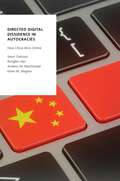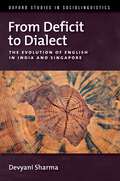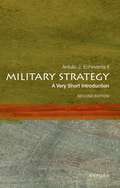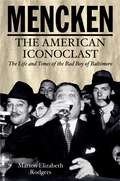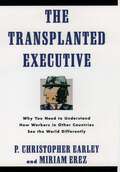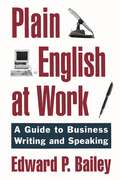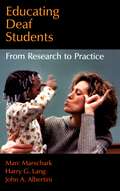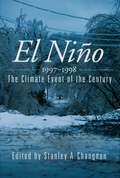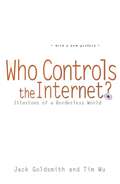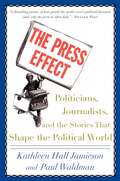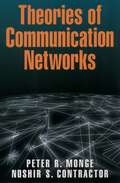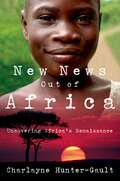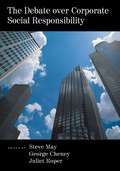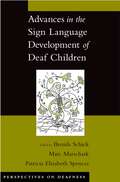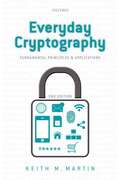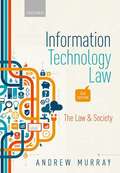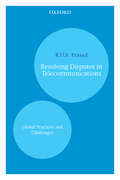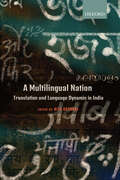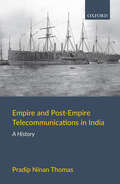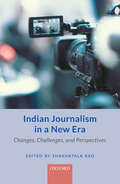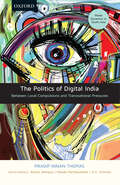- Table View
- List View
Directed Digital Dissidence in Autocracies: How China Wins Online (Oxford Studies in Digital Politics)
by Jason Gainous Rongbin Han Andrew W. MacDonald Kevin M. WagnerDoes the Internet fundamentally change the flow of politically relevant information, even in authoritarian regimes? If so, does it alter the attitudes and behavior of citizens? While there is a fair amount of research exploring how social media has empowered social actors to challenge authoritarian regimes, there is much less addressing whether and how the state can actively shape the flow of information to its advantage. In China, for instance, citizens often resort to "rightful resistance" to lodge complaints and defend rights. By using the rhetoric of the central government, powerless citizens may exploit the slim political opportunity structure and negotiate with the state for better governance. But this tactic also reinforces the legitimacy of authoritarian states; citizens engage rightful resistance precisely because they trust the state, at least the central government, to some degree. Drawing on original survey data and rich qualitative sources, Directed Digital Dissidence in Autocracies explores how authoritarian regimes employ the Internet in advantageous ways to direct the flow of online information. The authors argue that the central Chinese government successfully directs citizen dissent toward local government through critical information that the central government places online--a strategy that the authors call "directed digital dissidence". In this context, citizens engage in low-level protest toward the local government, and thereby feel empowered, while the central government avoids overthrow. Consequently, the Internet functions to discipline local state agents and to project a benevolent image of the central government and the regime as a whole. With an in-depth look at the COVID-19 and Xinjiang Cotton cases, the authors demonstrate how the Chinese state employs directed digital dissidence and discuss the impact and limitations of China's information strategy.
From Deficit to Dialect: The Evolution of English in India and Singapore (Oxford Studies in Sociolinguistics)
by Devyani SharmaThe emergence of new English dialects in postcolonial regions has transformed the politics of English in the world and language ecologies in many regions. Why, how, and when did these dialects develop? Why do they have the accents and grammars that we hear? Are the grammars of these dialects completely different due to the influence of local languages, or similar due to natural tendencies in human cognition? In terms of social identity, do these new speakers behave like native speakers of British or American English, or like language learners? Focusing on two prominent cases; English in India and in Singapore; this book examines the social, historical, and cognitive forces that together created and continue to shape these dialects. Differences in the linguistic ecology of the two regions help us to identify the strongest mechanisms of dialect formation under long-term cultural contact. The multi-scale analysis of a range of bilinguals moves beyond a simplistic divide between 'deficit' and 'dialect' views of these speech communities, showing that change proceeds unevenly across the language system and the social group, with feedback loops between social history, language learning, language structure, and identity.
Military Strategy: Second Edition (Very Short Introductions)
by Antulio J. Echevarria IIDistilling the ideas of the greatest military theoreticians of history, including Sun Tzu, Niccol? Machiavelli, and Carl von Clausewitz, this clear and engaging Very Short Introduction presents a fascinating account of the "art of the general." Antulio J. Echevarria II highlights the dynamic relationship between the main elements of strategy: purpose, method, and means. Drawing on historical examples, he discusses the major types of military strategy and how emerging technologies are affecting them. This second edition has been updated throughout, and now includes an extended chapter on cyberwarfare which shows how the use of social media platforms to influence opinions on political views and manipulate populations to act in certain ways has evolved from an art to a science.
Military Strategy: Second Edition (Very Short Introductions)
by Antulio J. Echevarria IIDistilling the ideas of the greatest military theoreticians of history, including Sun Tzu, Niccol? Machiavelli, and Carl von Clausewitz, this clear and engaging Very Short Introduction presents a fascinating account of the "art of the general." Antulio J. Echevarria II highlights the dynamic relationship between the main elements of strategy: purpose, method, and means. Drawing on historical examples, he discusses the major types of military strategy and how emerging technologies are affecting them. This second edition has been updated throughout, and now includes an extended chapter on cyberwarfare which shows how the use of social media platforms to influence opinions on political views and manipulate populations to act in certain ways has evolved from an art to a science.
Mencken: The American Iconoclast
by Marion Elizabeth RodgersA towering figure on the American cultural landscape, H.L. Mencken stands out as one of our most influential stylists and fearless iconoclasts--the twentieth century's greatest newspaper journalist, a famous wit, and a constant figure of controversy. Marion Elizabeth Rodgers has written the definitive biography of Mencken, the finest book ever published about this giant of American letters. Rodgers illuminates both the public and the private man, covering the many love affairs, his happy marriage at the age of 50 to Sara Haardt, and his complicated but stimulating friendship with the famed theater critic George Jean Nathan. Rodgers vividly recreates Mencken's era: the glittering tapestry of turn-of-the-century America, the roaring twenties, depressed thirties, and the home front during World War II. But the heart of the book is Mencken. When few dared to shatter complacencies, Mencken fought for civil liberties and free speech, playing a prominent role in the Scope's Monkey Trial, battling against press censorship, and exposing pious frauds and empty uplift. The champion of our tongue in The American Language, Mencken also played a pivotal role in defining American letters through The Smart Set and The American Mercury, magazines that introduced such writers as James Joyce, F. Scott Fitzgerald, and Langston Hughes. Drawing on research in more than sixty archives including private collections in the United States and in Germany, previously unseen, on exclusive interviews with Mencken's friends, and on his love letters and FBI files, here is the full portrait of one of America's most colorful and influential men. "This biography, the best ever on the sage of Baltimore, is exhaustive but never exhausting, and offers readers more than moderate intelligence and an awfully good time." --Martin Nolan, Boston Globe
The Transplanted Executive: Why You Need To Understand How Workers In Other Countries See The World Differently
by P. Christopher Earley Miriam ErezPlain English at Work: A Guide to Writing and Speaking
by Edward P. BaileyEveryday we write countless memos, letters, and reports without a second thought. Likewise, we give presentations, both formal and informal. Often this writing and speaking gets criticized for being jargon-ridden, obscure, or long-winded--in short, for not being in "plain English." But what is plain English, and how do we go about writing and speaking it? In Plain English at Work, Edward Bailey gives the answer, with down-to-earth tips and practical advice. Bailey, an expert in business communication, gives us a simple model for writing: BL Style: write more the way you talk. BL Organization: make your point easy to find. BL Layout: use headings, lists, and other white space so readers can see the structure of your writing. Psycholinguists, Bailey points out, have proven that the techniques of plain English writing are far easier on your readers; experience has proven that writing in plain English is easier on you--the writer, too. Bailey also gives you a wealth of practical advice for presentations including: BL How to remember your talk. BL How to design visual aids. BL How to design computer presentations. BL How to set up the room you'll be speaking in. BL How to develop a successful delivery style. Perhaps most impressive are the many detailed tips he gives here. For instance, when using a pointer, hold it in the hand closer to the screen (otherwise, you turn your back on the audience, making it harder to hear you). When designing a visual aid, use at least 28-point type, and seldom use all capital letters (which are harder to read). And when presenting a bar chart during a computer presentation, build it--a bar at a time--to focus your audience's attention. Drawing on two earlier and popular books, The Plain English Approach to Business Writing and A Practical Guide for Business Speaking, this new volume has been significantly updated. It includes up-to-the-minute information on using computers, computer graphics, and typography for your writing, and on using the same technology for designing your presentations. The result is an authoritative and comprehensive single volume that will be the essential guide for everyone wishing to communicate more easily and effectively at work.
Educating Deaf Students: From Research to Practice
by Marc Marschark Harry G. Lang John A. AlbertiniOver the past decade there has been a significant increase in interest from educators and the general public about deafness, special education, and the development of children with special needs. The education of deaf children in the United States has been seen as a remarkable success story around the world, even while it continues to engender domestic debate. In Educating Deaf Students: From Research to Practice, Marc Marschark, Harry G. Lang, and John A. Albertini set aside the politics, rhetoric, and confusion that often accompany discussions of deaf education. Instead they offer an accessible evaluation of the research literature on the needs and strengths of deaf children and on the methods that have been used-successfully and unsuccessfully-to teach both deaf and hearing children. The authors lay out the common assumptions that have driven deaf education for many years, revealing some of them to be based on questionable methods, conclusions, or interpretations, while others have been lost in the cacophony of alternative educational philosophies. They accompany their historical consideration of how this came to pass with an evaluation of the legal and social conditions surrounding deaf education today. By evaluating what we know, what we do not know, and what we thought we knew about learning among deaf children, the authors provide parents, teachers, and administrators valuable new insights into educating deaf students and others with special needs.
El Niño 1997-1998: The Climate Event of the Century
by Stanley A. ChangnonThis book will cover the time span from the first indications of El Nino (May 1997) until its reversal (June 1998). The focus will be largely on the United States, where El Nino produced widespread changes in how the public perceives weather and in the accuracy of forecasts Among the key issues it will examine are how the news media interpreted and dramatixed El Nino and the reaction both of the public and decision-makers (the latter based on interviews with agribusiness, utilities, water management agencies, etc.); the scientific issues emerging from the event; and the social and economic consequences of the event. Finally, it will suggest what can and should be done when El Nino occurs in the future.
Who Controls the Internet?: Illusions of a Borderless World
by Jack Goldsmith Tim WuIs the Internet erasing national borders? Will the future of the Net be set by Internet engineers, rogue programmers, the United Nations, or powerful countries? Who's really in control of what's happening on the Net? In this provocative new book, Jack Goldsmith and Tim Wu tell the fascinating story of the Internet's challenge to governmental rule in the 1990s, and the ensuing battles with governments around the world. It's a book about the fate of one idea--that the Internet might liberate us forever from government, borders, and even our physical selves. We learn of Google's struggles with the French government and Yahoo's capitulation to the Chinese regime; of how the European Union sets privacy standards on the Net for the entire world; and of eBay's struggles with fraud and how it slowly learned to trust the FBI. In a decade of events the original vision is uprooted, as governments time and time again assert their power to direct the future of the Internet. The destiny of the Internet over the next decades, argue Goldsmith and Wu, will reflect the interests of powerful nations and the conflicts within and between them. While acknowledging the many attractions of the earliest visions of the Internet, the authors describe the new order, and speaking to both its surprising virtues and unavoidable vices. Far from destroying the Internet, the experience of the last decade has lead to a quiet rediscovery of some of the oldest functions and justifications for territorial government. While territorial governments have unavoidable problems, it has proven hard to replace what legitimacy governments have, and harder yet to replace the system of rule of law that controls the unchecked evils of anarchy. While the Net will change some of the ways that territorial states govern, it will not diminish the oldest and most fundamental roles of government and challenges of governance. Well written and filled with fascinating examples, including colorful portraits of many key players in Internet history, this is a work that is bound to stir heated debate in the cyberspace community.
The Press Effect: Politicians, Journalists, and the Stories that Shape the Political World
by Kathleen Hall Jamieson Paul WaldmanWas the 2000 presidential campaign merely a contest between Pinocchio and Dumbo? And did Dumbo miraculously turn into Abraham Lincoln after the events of September 11? In fact, Kathleen Hall Jamieson and Paul Waldman argue in The Press Effect, these stereotypes, while containing some elements of the truth, represent the failure of the press and the citizenry to engage the most important part of our political process in a critical fashion. Jamieson and Waldman analyze both press coverage and public opinion, using the Annenberg 2000 survey, which interviewed more than 100,000 people, to examine one of the most interesting periods of modern presidential history, from the summer of 2000 through the aftermath of September 11th. How does the press fail us during presidential elections? Jamieson and Waldman show that when political campaigns side-step or refuse to engage the facts of the opposing side, the press often fails to step into the void with the information citizens require to make sense of the political give-and-take. They look at the stories through which we understand political events-examining a number of fabrications that deceived the public about consequential governmental activities-and explore the ways in which political leaders and reporters select the language through which we talk and think about politics, and the relationship between the rhetoric of campaigns and the reality of governance. The Press Effect is, ultimately, a wide-ranging critique of the press's role in mediating between politicians and the citizens they are supposed to serve.
Theories of Communication Networks
by Peter R. Monge Noshir ContractorTo date, most network research contains one or more of five major problems. First, it tends to be atheoretical, ignoring the various social theories that contain network implications. Second, it explores single levels of analysis rather than the multiple levels out of which most networks are comprised. Third, network analysis has employed very little the insights from contemporary complex systems analysis and computer simulations. Foruth, it typically uses descriptive rather than inferential statistics, thus robbing it of the ability to make claims about the larger universe of networks. Finally, almost all the research is static and cross-sectional rather than dynamic. Theories of Communication Networks presents solutions to all five problems. The authors develop a multitheoretical model that relates different social science theories with different network properties. This model is multilevel, providing a network decomposition that applies the various social theories to all network levels: individuals, dyads, triples, groups, and the entire network. The book then establishes a model from the perspective of complex adaptive systems and demonstrates how to use Blanche, an agent-based network computer simulation environment, to generate and test network theories and hypotheses. It presents recent developments in network statistical analysis, the p* family, which provides a basis for valid multilevel statistical inferences regarding networks. Finally, it shows how to relate communication networks to other networks, thus providing the basis in conjunction with computer simulations to study the emergence of dynamic organizational networks.
New News Out of Africa: Uncovering Africa's Renaissance
by Charlayne Hunter-GaultFor twenty years an acclaimed correspondent on PBS's The News Hour with Jim Lehrer and the winner of two Emmys and two Peabody Awards (the latter two for her coverage of Africa), Charlayne Hunter-Gault was until recently the Johannesburg Bureau Chief for CNN. In New News Out of Africa, this eminent reporter offers a fresh and surprisingly optimistic assessment of modern Africa, revealing that there is more to the continent than the bad news of disease, disaster, and despair. Blending personal memoir with sterling reportage and astute analysis, Hunter Gault presents an Africa we rarely see. She looks first at South Africa, contrasting the country she first encountered as a young reporter--when she personally witnessed the brutality of apartheid--with the black-led, multiracial society of today, a nation undergoing one of the most radical social and economic experiments in modern times. She acknowledges the great imbalance in income in modern South Africa (where upwards of 30 to 40 percent of blacks are unemployed) and describes the ravaging effect of AIDS on the nation, but she also underscores the nation's commitment to affirmative action, describes how South African universities have opened their doors to black students, and debunks many of the myths about the violence of South African society. Likewise, Hunter-Gault looks at the continent-wide efforts to promote "an African Renaissance," illuminating the political and economic conditions in Rwanda, Mozambique, Nigeria, Ghana, Kenya, Angola, and Sierra Leone. Finally, the book describes the challenges of reporting on the much-maligned continent and the efforts of African journalists to tell their own story. A compelling book on a topic of vital importance, New News Out of Africa promises to re-define what is news about this vast and complex continent.
The Debate over Corporate Social Responsibility
by Steven K. May George Cheney Juliet RoperShould business strive to be socially responsible, and if so, how? The Debate over Corporate Social Responsibility updates and broadens the discussion of these questions by bringing together in one volume a variety of practical and theoretical perspectives on corporate social responsibility. It is perhaps the single most comprehensive volume available on the question of just how "social" business ought to be. The volume includes contributions from the fields of communication, business, law, sociology, political science, economics, accounting, and environmental studies. Moreover, it draws from experiences and examples from around the world, including but not limited to recent corporate scandals and controversies in the U.S. and Europe. A number of the chapters examine closely the basic assumptions underlying the philosophy of socially responsible business. Other chapters speak to the practical challenges and possibilities for corporate social responsiblilty in the twenty-first century. One of the most distinctive features of the book is its coverage of the very ways that the issue of corporate social responsibility has been defined, shaped, and discussed in the past four decades. That is, the editors and many of the authors are attuned to the persuasive strategies and formulations used to talk about socially responsible business, and demonstrate why the talk matters. For example, the book offers a careful analysis of how certain values have become associated with the business enterprise and how particular economic and political positions have been established by and for business. This book will be of great interest to scholars, business leaders, graduate students, and others interested in the contours of the debate over what role large-scale corporate commerce should take in the future of the industrialized world.
Advances in the Sign Language Development of Deaf Children (Perspectives on Deafness)
by Brenda Schick Marc Marschark Patricia Elizabeth SpencerThe use of sign language has a long history. Indeed, humans' first languages may have been expressed through sign. Sign languages have been found around the world, even in communities without access to formal education. In addition to serving as a primary means of communication for Deaf communities, sign languages have become one of hearing students' most popular choices for second-language study. Sign languages are now accepted as complex and complete languages that are the linguistic equals of spoken languages. Sign-language research is a relatively young field, having begun fewer than 50 years ago. Since then, interest in the field has blossomed and research has become much more rigorous as demand for empirically verifiable results have increased. In the same way that cross-linguistic research has led to a better understanding of how language affects development, cross-modal research has led to a better understanding of how language is acquired. It has also provided valuable evidence on the cognitive and social development of both deaf and hearing children, excellent theoretical insights into how the human brain acquires and structures sign and spoken languages, and important information on how to promote the development of deaf children. This volume brings together the leading scholars on the acquisition and development of sign languages to present the latest theory and research on these topics. They address theoretical as well as applied questions and provide cogent summaries of what is known about early gestural development, interactive processes adapted to visual communication, linguisic structures, modality effects, and semantic, syntactic, and pragmatic development in sign. Along with its companion volume, Advances in the Spoken Language Development of Deaf and Hard-of Hearing Children, this book will provide a deep and broad picture about what is known about deaf children's language development in a variety of situations and contexts. From this base of information, progress in research and its application will accelerate, and barriers to deaf children's full participation in the world around them will continue to be overcome.
Numicon: Breakng Barriers Assessment and Photocopy Masters (PDF)
by Tony Wing Romey Tacon Ruth AtkinsonNumicon is a proven approach for teaching and learning maths that builds deep understanding and engagement. Through active investigation with problem-solving at its heart and supported by structured apparatus, children reason and communicate mathematically with confidence. Breaking Barriers is specifically designed for teaching children who experience particular difficulties learning maths, including those with special educational needsanddisabilities. The Assessment and Photocopy Masters book contains Assessment Signposts for ensuring that teaching starts at an appropriate point, an Individual Record of Progress providing detailed trackingfor each child, a Child Profile for building a picture of strengths and difficulties so that specific needs can be addressed, and Photocopy masters to support the activities in the Teaching Handbook.
Everyday Cryptography: Fundamental Principles And Applications (PDF)
by Keith MartinCryptography is a vital technology that underpins the security of information in computer networks. This book presents a comprehensive introduction to the role that cryptography plays in providing information security for everyday technologies such as the Internet, mobile phones, Wi-Fi networks, payment cards, Tor, and Bitcoin. This book is intended to be introductory, self-contained, and widely accessible. It is suitable as a first read on cryptography. Almost no prior knowledge of mathematics is required since the book deliberately avoids the details of the mathematics techniques underpinning cryptographic mechanisms. Instead our focus will be on what a normal user or practitioner of information security needs to know about cryptography in order to understand the design and use of everyday cryptographic applications. By focusing on the fundamental principles of modern cryptography rather than the technical details of current cryptographic technology, the main part this book is relatively timeless, and illustrates the application of these principles by considering a number of contemporary applications of cryptography. Following the revelations of former NSA contractor Edward Snowden, the book considers the wider societal impact of use of cryptography and strategies for addressing this. A reader of this book will not only be able to understand the everyday use of cryptography, but also be able to interpret future developments in this fascinating and crucially important area of technology.
Data at the Boundaries of European Law (Collected Courses of the Academy of European Law)
Data at the Boundaries of European Law represents an original and engaged piece of scholarship in an important and fast developing field of policy and research. Beyond, and including, the most recent major new pieces of EU legislation-the Data Governance Act, together with the Data Act and the AI Act still going through the legislative process-this book draws attention to the substance of a number of core themes of the relationship between law and the digital world that are still somewhat hidden. These themes include the mimetic regulatory trajectories in and around the GDPR, transparency, ownership, and accountability, as well as the translation of all of these into core areas of public law such as criminal law, migration law, and intellectual property law. As a result, this book occupies a distinctive place in the debate on digital law that goes beyond the various silos of knowledge of particular legal disciplines. The issues addressed in this book are of interest to a global readership. They grapple with a number of the difficult themes of our times as applied to private and public actors and their (future) regulation in a manner that is relevant not just in Europe but worldwide.
Data at the Boundaries of European Law (Collected Courses of the Academy of European Law)
by Deirdre Curtin and Mariavittoria CatanzaritiData at the Boundaries of European Law represents an original and engaged piece of scholarship in an important and fast developing field of policy and research. Beyond, and including, the most recent major new pieces of EU legislation-the Data Governance Act, together with the Data Act and the AI Act still going through the legislative process-this book draws attention to the substance of a number of core themes of the relationship between law and the digital world that are still somewhat hidden. These themes include the mimetic regulatory trajectories in and around the GDPR, transparency, ownership, and accountability, as well as the translation of all of these into core areas of public law such as criminal law, migration law, and intellectual property law. As a result, this book occupies a distinctive place in the debate on digital law that goes beyond the various silos of knowledge of particular legal disciplines. The issues addressed in this book are of interest to a global readership. They grapple with a number of the difficult themes of our times as applied to private and public actors and their (future) regulation in a manner that is relevant not just in Europe but worldwide.
Resolving Disputes in Telecommunications: Global Practices and Challenges
by R.U.S PrasadThe Indian telecommunication sector has seen far-reaching changes in the last two decades due to increasing globalization, rapid pace of technological innovations, and rising consumer demands. Myriad and complex problems have arisen as a result of these developments. Though attempts have been made to tackle these issues at the levels of policymaking, regulation, and dispute settlement, these have not been able to keep pace with the rapidly changing scenario, often leading to paralysing dispute situations. In this important and timely volume, the author focuses on the so far neglected area of dispute resolution. The work delves into the disputes arising from increased competition, heightened consumer expectations, and the need to balance competition and universal service obligation. Beginning with the theoretical underpinnings of dispute resolution, the author analyses various methods such as regulatory-based adjudication, alternative dispute resolution (ADR), and resolution by sector-specific tribunals. He compares the management and disputes resolution practices followed in countries such as the UK, France, Germany, Denmark, the USA, and Canada, to arrive at a framework for a more effective mode of dispute resolution.
A Multilingual Nation: Translation and Language Dynamic in India
by Rita KothariHow does India live through the oddity of being both a nation and multilingual? Is multilingualism in India to be understood as a neatly laid set of discrete languages or a criss-crossing of languages that runs through every source language and text? The questions take us to reviewing what is meant by language, multilingualism, and translation. Challenging these institutions, A Multilingual Nation illustrates how the received notions of translation discipline do not apply to India. It provocatively argues that translation is not a ‘solution’ to the allegedly chaotic situation of many languages, rather it is its inherent and inalienable part. An unusual and unorthodox collection of essays by leading thinkers and writers, new and young researchers, it establishes the all-pervasive nature of translation in every sphere in India and reverses the assumptions of the steady nature of language, its definition, and the peculiar fragility that is revealed in the process of translation.
Empire and Post-Empire Telecommunications in India: A History
by Pradip Ninan ThomasTelecommunications was vital to the imperial project and connecting India—the jewel in the British crown—was a key priority. However, intercolonial rivalries outside and within India as well as contestations between private and public ownership of telecommunications made that task difficult. The author explores these differences and ties the history of telegraph, cable, and wireless in British India to the evolving story of telecommunications in post-Independence India. This book examines the role of the telegraph, oceanic cables, and the wireless in the context of the political economy and compulsions of Empire to control global flows of communications. It argues that history is absolutely critical to understanding the present, and the imprint of the past continues to shape the Indian state’s engagements with telecommunications. This volume undertakes the project of bridging the gap between past and present, and highlighting a narrative of time- and space-specific innovation and growth tempered by political circumstances, geopolitical developments, and economic compulsions.
Indian Journalism in a New Era: Changes, Challenges, and Perspectives
by Shakuntala RaoIn the ever-changing information environment of the early twenty-first century, citizens and journalists alike are eagerly adapting to new technologies, and India is no different. The country’s communication revolution in the post-liberalization era has led to one of the largest media markets in the world. Further, changes in media ownerships and the blending of news with opinions have impacted established practices of reporting. Given the breadth and scope of India’s media, there is little meaningful literature available about journalism practised in the country today. Indian Journalism in a New Era brings together informative and critical contributions about contemporary Indian journalism from twenty-one Indian and global scholars and journalists. The book is divided into four different sections, each addressing one relevant aspect: history and evolving changes; social media and e-journalism; marginalization; and pedagogy, ethics, and public sphere. The contributors address issues like changes in journalism practices, socio-economic conditions of the Indian state, and minority politics. Holistically, the volume focuses on the ways to approach and analyse the enormity and scope in Indian journalism, media technology, and global relations.
The Politics of Digital India: Between Local Compulsions and Transnational Pressures (Media Dynamics in South Asia)
by Pradip Ninan ThomasTransforming India into a digital state has been an objective of successive governments in India. However, the digital, by its very nature, is a capricious, multi-dimensional entity. Its operationalization across multiple sectors in India has highlighted the fact that the digital compact with publics in India is a two-edged sword. On the one hand, devices such as mobile phones have enabled access and efficiencies, and on the other, they have increased the scope for surveillance capitalism and the expansion of governmentality. The digital is at the same time a resource, commodity, and process that is absolutely fundamental to most if not all productive forces across multiple sectors. As a part of the Media Dynamics in South Asia series, this volume explores the making of digital India and specifically deals with the contradictions of an imperfect democracy, internal compulsions, and external pressures that continue to play crucial roles in the shaping of the same. Mindful of the key roles played by political economy and context and based on conversations with theory and practice, it makes a case for critical understanding of the digital embrace in India.
